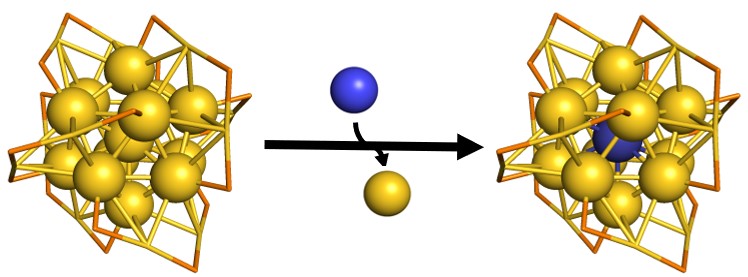Gold Nanoclusters
PROJECT SUMMARY: With support from the Macromolecular, Supramolecular and Nanochemistry Program (MSN) in the Division of Chemistry, Professor Christopher Ackerson of Colorado State University is combining chemical synthesis and advanced chemical analysis tools to study how different types of molecules compete for bonding sites on the surfaces of clusters of gold atoms. These surfaces can be low-symmetry, meaning that many different types of bonding sites are present. Different types of molecules prefer different types of bonding sites. Some molecules will bond to two sites at the same time. To determine which molecules prefer which binding sites, Professor Ackerson and his students make well-defined gold clusters, such as Au25, which has 18 molecule binding sites. They mix Au25 with other molecules and use advanced imaging methods to see where the molecules bind. In the long term, they want to write rules that describe where molecules will bind to metal clusters. Their discoveries could lead to methods for making large molecules that cannot currently be synthesized. Those molecules could find use in catalysis, as labels in microscopy, and as medicines. The award supports a workshop that brings together synthetic experts from different sub-specialties in chemistry, as well as training the diverse future scientific workforce.

Professor Ackerson aims to transform current understanding of regiochemical control of ligands on metal nanoparticle surfaces. The specific system examined is that of thiolate, acetylide, and similar ligands on magic number gold clusters. These clusters are of low symmetry (e.g., conforming to C2, i, and similar point groups), meaning that there are many symmetry-unique ligand binding sites. The overall goals are to understand the regiochemistry of monodentate ligands on such gold nanoclusters and to determine structurally how bidentate thiolate ligands bind to magic number gold clusters. Questions addressed include: (1) What reaction mechanisms access sites with long-term lifetimes? (2) Do thiolates with distinctive or demanding R-groups localize to specific regiochemical sites based on their shape? (3) Do acetylide ligands exchange associatively under ambient conditions? (4) What is the structural nature of bidentate thiol ligand binding? (5) Do bidentate ligands achieve useful lifetimes (days to weeks) in ambient conditions where monodentate ligands continue to exchange? (6) Can a magic-number cluster protected exclusively by bidentate ligands be produced and crystallized? These questions are addressed with methodological approaches including MALDI-MS to determine extent of ligand exchange, and either single crystal X-ray diffraction or multidimensional NMR spectroscopy to determine regiochemistry of ligand-exchange products.

During his time in the Kornberg lab, Dr. Ackerson contributed to the solution of the first gold nanocluster crystal structure, Au102(SR)44 (SR = thiolate). Research in our lab includes Au102 as well as other nuclearities such as Au25 and Au144. Our group attempts to further elucidate fundamental aspects of these nanoclusters, most often through post-synthetic modification and characterization.

